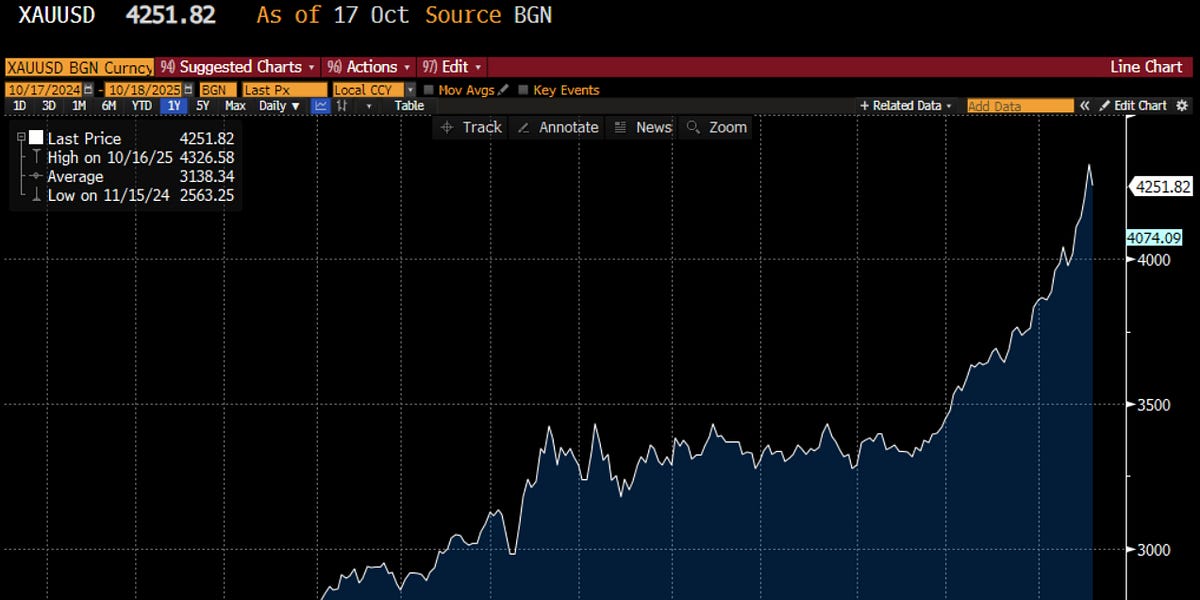Every once in a while, the IMF/WB annual meetings can move markets. That happens when discussion at these meetings coalesces around one particular market move that becomes a singular focus of discussion. The last time this happened was in October 2023, when the 10-year Treasury yield had pushed up near 5 percent in the run-up to those meetings – it’s highest level since 2007 – and no one could figure out why. Every meeting began with the same question: “Why has 10-year gone up so much?” In effect, those meetings became a week-long debate on whether this move made sense. Most people concluded that it didn’t. In the weeks that followed, 10-year yield fell back and hasn’t had the temerity to go back up near 5 percent ever since.
It’s the same with gold this week. In the run-up to this week’s meetings, gold prices had risen almost 30 percent, a move that started with Chair Powell’s dovish speech at Jackson Hole on August 22. Much as two years ago, there was general bafflement over what’s powering this move, so almost every meeting started with this question: “Why are gold prices up so much?” My impression is that most people are coming away from these meetings thinking this is a bubble. They’re now boarding trains and planes and will spread the word. This kind of thing can move markets. The coming week will be a decisive one for gold.
As it happens, gold prices fell almost two percent yesterday – as the chart shows – but that doesn’t mean much. We’ve seen a tremendous rise in gold prices since August 22, so this may simply be a short-lived pull-back. Instead of getting caught up in day-to-day price action or a fruitless discussion on what “flow” is driving this rally, I’ll use this post to summarize the debate around gold at this week’s meetings and give my impression of where we ended up.
There’s three fundamental drivers people talk about: (i) geopolitical uncertainty, which includes tariffs, the ongoing war in Ukraine and Western sanctions on Russia; (ii) the state of the US economy, whether it’s headed for recession and how much the Fed may cut in response; and (iii) the post-COVID global debt overhang and ongoing fiscal recklessness in many places that many think can only end in debasement. There is broad consensus that Russia sanctions caused some central banks to diversify out of the Dollar into gold, but there’s an equally broad consensus that this is mostly “old news” and not a driver of what’s going on now. The global debt overhang and fiscal recklessness are equally important, but – again – this belongs in the “old news” category and can’t really explain why gold took off so recently.
So, in the end, the debate on gold coalesced around the state of the US economy and what the Fed will do. It’s here that I think this week may have changed some minds. A lot of the crowd at the IMF/WB meetings tends to be from Europe, where skepticism towards the US runs very high these days. These folks will be flying home having been inundated all week with chatter about the AI investment boom and its potential for productivity gains. They’ll have seen that DC is pretty much as it always is and that life goes on, regardless of who’s in the White House. My best guess is that they will – however grudgingly – upgrade their US growth view, which means they’ll also pare back their expectations for Fed cuts. That’s a cyclical upgrade that can put a stop to the massive rise in gold prices, at least for a little while.


